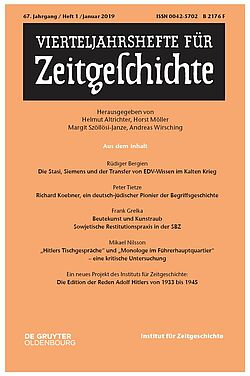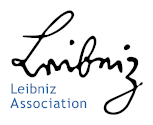- The Institute
- Research
- Dictatorships in the 20th Century
- Democracies and their Historical Self-Perceptions
- Transformations in Most Recent History
- International and Transnational Relations
- Edited Source Collections
- Dissertation Projects
- Completed Projects
- Dokumentation Obersalzberg
- Center for Holocaust Studies
- Berlin Center for Cold War Studies
- Publications
- Vierteljahrshefte
- The Archives
- Library
- Center for Holocaust Studies
- News
- Dates
- Press
- Recent Publications
- News from the Institute
- Topics
- Munich 1972
- Confronting Decline
- Feminist, Pacifist, Provocateur
- Der Mauerbau als Audiowalk
- Digital Contemporary History
- Transportation in Germany
- Envisaged Futures at the End of the Cold War
- From the Reichsbank to the Bundesbank
- German Federal Chancellery
- History of Sustainabilities: Discourses and Practices since the 1970s
- Changing Work
- Democratic Culture and the Nazi Past
- The History of the Treuhandanstalt
- Foreign Policy Documentation (AAPD)
- Dokumentation Obersalzberg
- Hitler, Mein Kampf. A Critical Edition
- "Man hört, man spricht"
- IfZ
- Vierteljahrshefte
- VfZ Archive
- Issue Index
- Issue January 2019
- Printversion
Issue 1/2019
Content Overview: English Titles and Abstracts:
- Rüdiger Bergien: Programming with the Class Enemy. The Stasi, Siemens and the Transfer of IT Knowledge during the Cold War.
- Peter Tietze: From Ostforschung to Historical Semantics. Richard Koebner, a German-Jewish Pioneer of Conceptual History.
- Frank Grelka: Stolen Art and Art Robbery. Soviet Compensation Practice in the Soviet Zone of Occupation in Germany.
- Mikael Nilsson: Hitler Redux. “Hitlers Tischgespräche” and “Monologe im Führerhauptquartier” – a Critical Examination.
Abstracts
Rüdiger Bergien, Programming with the Class Enemy. The Stasi, Siemens and the Transfer of IT Knowledge during the Cold War
Siemens computers in the service of the Stasi – this reminds us of illegal transfers of technology and of how the East German Ministry of State Security (Ministerium für Staatssicherheit, MfS, colloquially known as the Stasi) used intricate methods of spying and smuggling to gain possession of western high-tech. In 1970, however, the Siemens West Berlin branch office delivered three of their most modern mainframes quite officially and with the blessing of the West German government to East Berlin’s Wuhlheide, the location of the front company disguising the computing centre of the Stasi. Technicians, programmers and Siemens sales personnel even provided “IT support” for Department XIII of the MfS and delivered spare parts, new software versions and peripheral equipment. Yet while Siemens was unsuccessfully waiting for follow-up orders from the GDR, Western technology enabled the Stasi to jump-start its moves towards digitalisation, which provided it with a leading place in comparison to its Eastern “sister state security services” until 1989.
Peter Tietze, From Ostforschung to Historical Semantics. Richard Koebner, a German-Jewish Pioneer of Conceptual History
The German-Jewish historian Richard Koebner (1885–1958) is among the most important pioneer of Conceptual History and Historical Semantics. But he was more than that: Before 1933 he was among the leading representatives of Ostforschung (Research on the East) and after emigration was among the co-founders of modern Israeli historiography. The “Age of Extremes” of the 20th century is reflected in his life in surprising clarity: The struggle against radical anti-liberalism and antisemitism during the Weimar Republic; immigration, a new beginning and the transfer of knowledge to Palestine; and finally his personal commitment towards an understanding in the Jewish-Arab conflict. Koebner met this challenge with his conceptual history, which was simultaneously a historiographical method, a theory of modernity, a critique of ideology as well as a novel form of chrono-politics.
Frank Grelka, Stolen Art and Art Robbery. Soviet Compensation Practice in the Soviet Zone of Occupation in Germany
Nazi Germany’s war against the Soviet Union inflicted devastating damage and also included the extensive robbery of works of art. Against this background, USSR demands for restitution and compensation after the defeat of Hitler’s regime were certainly justified. In fact though the practice of relocating art to the Soviet Union went far beyond the principle of restitution in kind. On the basis of new sources from Russian state archives, East European historian Frank Grelka can show that this was no accident, but instead fitted with the plans of the respective staffs in Moscow which had received Stalin’s blessing. He discusses political motives, ideological legitimation patterns and addresses the role of German experts in this process. In doing so, he questions the interpretation of this process as a “relocation of art from the Soviet Zone of Occupation as a form of compensation for Nazi art robbery” as formulated in a law passed by the Russian Duma in 1998, which declared the respective cultural goods to be the property of the Russian state.
Mikael Nilsson, Hitler Redux. “Hitlers Tischgespräche” and “Monologe im Führerhauptquartier” – a Critical Examination
This pioneering study of the famous Hitler table talks – “Tischgespräche im Führerhauptquartier” (1951) and “Monologe im Führerhauptquartier” (1980) – uses a lot of previously unknown or overlooked sources to show that historians have been much too uncritical when citing these documents. The texts, the originals of which are now lost, were heavily edited and cannot be cited as being Hitler’s words ad verbatim. They are not more reliable than comparable notes. The notes were written down almost entirely from memory after the conversations they record, often finished long after the first drafts were written. Text was added during the editing process, and the notes contain statements that Hitler most likely did not make. Historians citing these texts are not quoting Hitler, but the words of the authors of the notes.
04/09/2024
„Die Lebensbeichte des Bandera-Mörders“
Der "Münchner Merkur" zu Grzegorz Rossoliński-Liebes Dokumentation im Aprilheft der VfZ
mehr
04/04/2024
„Die Beichte des Mörders von Stepan Bandera“
Die „Süddeutsche Zeitung“ zu Grzegorz Rossoliński-Liebes Dokumentation im Aprilheft der VfZ
mehr
04/02/2024
Druckfrisch: VfZ 2/2024
Das Aprilheft der Vierteljahrshefte für Zeitgeschichte ist erschienen
mehr








